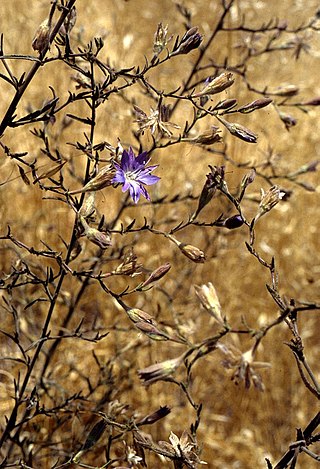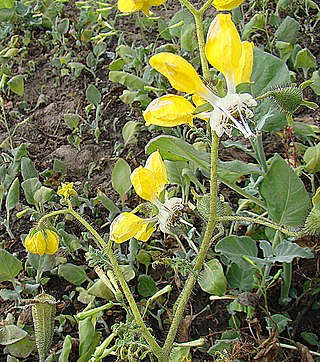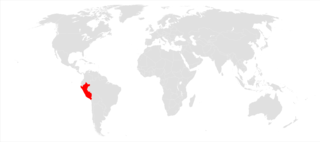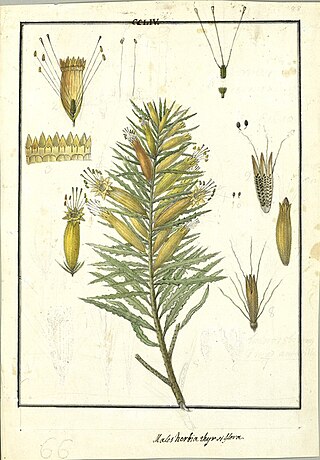Ctenoblepharys adspersa is a liolaemid lizard within the monotypic genus Ctenoblepharys. It is endemic to the arid western coast of Peru. It is locally known as cabezona.

LachayNational Reserve is a protected area in the region of Lima, Peru. The reserve is located 105 kilometres (65 mi) north from the Peruvian capital, Lima, and protects part of the lomas ecosystem.

Cerros de Amotape National Park is a protected area located in the regions of Piura and Tumbes in northern Peru.

Malesherbia is a genus of flowering plants consisting of 25 species in the Passifloraceae. This is a xerophytic group endemic to the Peruvian and Chilean deserts and adjacent Argentina. The genus is currently recognized by the APG III system of classification in the family Passifloraceae, and is the sole member of the subfamily Malesherbioideae.
Sunchubamba is a game reserve in the region of Cajamarca, Peru.

Nasa is a genus of plants in the family Loasaceae containing over 100 known species, all of which are found in South America with the exception of two species endemic to Central America. They are common in submontane to montane environments.

Allpahuayo-Mishana National Reserve is a protected area in Peru located southwest of Iquitos in the region of Loreto. It was established in 2004 to protect the diverse forest types in the area, especially the rainforests on white sandy soil and watercourses which provide drinking water to the city of Iquitos.
Eucrosia calendulina is a species of plant that is endemic to Peru.
Berberis weberbaueri is a shrub in the Berberidaceae described as a species in 1908. It is endemic to Peru, found in the regions of Ancash, Cajamarca, La Libertad, and Lambayeque.

Krapfia weberbaueri is a plant in the family Ranunculaceae. It is endemic to Peru.

Chionopsis gnidia, is a species of medium-sized saltwater clam, a marine bivalve mollusc in the family Veneridae, the venus clams. It was originally described in 1829 by W. J. Borderip and G. B. Sowerby as Venus gnidia. It can be found throughout the coasts of the United States to Peru.

Malesherbia angustisecta is an endangered member of Malesherbia (Passifloraceae). It is colloquially called clavelina.

Malesherbia arequipensis is a herbaceous member of Malesherbia (Passifloraceae) with white flowers. It first described in 1961 by botanist Mario H. Ricardi Salinas and is native to Arequipa and Moquegua. It is the only member of Malesherbia that grows outside of the Andes. It grows up to 15 cm tall and has white flowers.

Malesherbia auristipulata is a perennial woody shrub in the genus Malesherbia (Passifloraceae). Locally it is called Ají de Zorra. M. auristipulata is commonly found in Northern Chili and rarely in Tacna, Peru. In general, the species range is very restricted as a result M. auristipulata is considered a rare plant. It is likely that there are less than 100 individuals left, classifying the species as critically endangered by the local government.
Malesherbia scarlatiflora is a shrub native to the pacific slopes of Peru. It grows up to 1 meter tall, has narrow ovate-acuminate leaves, and orange flowers.
Malesherbia splendens is a shrub in the genus Malesherbia. It is colloquially known as Moro, Fox Tail, and Veronica.
Malesherbia tenuifolia is an vulnerable subshrub native to Candarave, Peru and Tarapacá, Chile. It is found at altitudes of 1550-2400m. It can grow up to 150cm tall, is ashy-green, and has dark red flowers.

Malesherbia tubulosa is subshrub native to central Peru. It is colloquially called Mullaca and Verónica. M. tubulosa can reach heights of 2 meters and has actinomorphic orange flowers.
Malesherbia turbinea is a shrub native Candarave, Tacna, Peru. It has been recorded growing near Lake Huananhuata.
Malesherbia weberbaueri is species of flowering plant in the family Passifloraceae. It is a subshrub native to Apurímac, Ayacucho, Huancavelica and Junín. It is found at altitudes of 2300-3600 meters.











